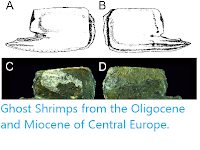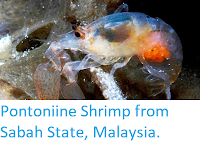Freshwater Shrimps of the genus Caridina are widely distributed in tropical and subtropical waters across Africa, Asia, Australia and Oceania. They are omnivores, able to consume a wide variety of foodstuffs, but often have very specific environmental tolerances, which results in a large number of species, most of which have very limited distributions. The genus was first reported in the Northern Territory in 1967, and the area is known to be home to a number of undescribed species.
In a paper published in the journal Zootaxa on 6 November 2019, John Short of BioAccess Australia, Timothy Page of the Australian Rivers Institute at Griffith University, and Christopher Humphrey of the Heritage, Reef and Marine Division of the Department of Environment & Energy, describe a new species of Caridina from the Leichhardt Springs hydrothermal system in the Kakadu National Park of Australia's Northern Territory.
Leichhardt Springs has two dominant outflows approximately 320 m apart, a north arm and a south arm, with a downstream confluence into the northern branch of Burdulba Creek. The heat source of Leichhardt Springs is presently undetermined although other thermal springs in the Alligator Rivers Region (including western Arnhem Land) are known to be associated with high heat-producing rocks in the basement of the crust. No other thermal springs are presently known from Kakadu National Park.
The thermal properties of Leichhardt Springs were investigated over a four to five-month period during the 2014 winter-spring dry season using two CTD-Diver multi-parameter dataloggers deployed on the north arm of Leichhardt Springs, one at the head of the spring and the other 160 m downstream. A third Diver was also deployed in Radon Springs, a non-thermal spring located approx. 6 km to the northeast on the large, outlying, sandstone formation above Leichhardt Springs (Fig. 1). Over the five-month period, water temperature at the head of the north arm spring was an invariant 30.2°C and 160 m downstream, almost constant and only slightly cooler, at 29.2–30.3°C. By comparison, Radon Springs showed a much higher temperature range, 22.1–29.3°C, thus 1–8°C cooler over the same period. A sampling trip to the south arm of Leichhardt Springs in June 2016 revealed thermal properties similar to the north arm.
Apart from its thermal properties, the location of Leichhardt Springs relative to the Kakadu-Arnhem Land plateau and escarpment complex is also interesting. Other sandstone-formation springs in Kakadu National Park arise within small gorges and typically at the immediate base of escarpments. Leichhardt Springs is located approximately 900 m away from the western escarpment of an outlying sandstone formation and at a lower elevation.
Satellite imagery of Leichhardt Springs shows extensive rainforest vegetation along both arms associated with the permanent, spring-fed outflows. The head of the north arm outflows through a patch of small, abraded and bleached, sandstone cobbles. For at least 300 m downstream, the north arm is characterised by a sequence of pools with clean, quartzite sand substrate interspersed with swift-flowing runs and riffles of gravel and cobble. Riparian trees include Melaleuca spp. (Paperbarks), Carallia brachiata (Corkwood), Pandanus aquaticus (Pandan), Canarium australianum (Mango Bark), Syzygium spp.(Lillipillies), and the monsoon rainforest-specific species, Nauclea orientalis (Yellow Cheesewood), and Melicope elleryana (Pink Flowered Doughwood). The understorey comprises climbing Vines, Flagellaria indica (Whip Vine), and Rhaphidophora australasica (Needle Berry), climbing Ferns, Stenochlaena palustris (Midin), groundstorey Ferns, Blechnum orientale (Oriental Blechnum) and the flowering shrub, Melastoma sp. (Melastomes). The macrophyte, Eleocharis sp. (Spikerush), is commonly interspersed amongst runs and riffles of the stream.
The thermal properties of Leichhardt Springs were investigated over a four to five-month period during the 2014 winter-spring dry season using two CTD-Diver multi-parameter dataloggers deployed on the north arm of Leichhardt Springs, one at the head of the spring and the other 160 m downstream. A third Diver was also deployed in Radon Springs, a non-thermal spring located approx. 6 km to the northeast on the large, outlying, sandstone formation above Leichhardt Springs (Fig. 1). Over the five-month period, water temperature at the head of the north arm spring was an invariant 30.2°C and 160 m downstream, almost constant and only slightly cooler, at 29.2–30.3°C. By comparison, Radon Springs showed a much higher temperature range, 22.1–29.3°C, thus 1–8°C cooler over the same period. A sampling trip to the south arm of Leichhardt Springs in June 2016 revealed thermal properties similar to the north arm.
Apart from its thermal properties, the location of Leichhardt Springs relative to the Kakadu-Arnhem Land plateau and escarpment complex is also interesting. Other sandstone-formation springs in Kakadu National Park arise within small gorges and typically at the immediate base of escarpments. Leichhardt Springs is located approximately 900 m away from the western escarpment of an outlying sandstone formation and at a lower elevation.
Satellite imagery of Leichhardt Springs shows extensive rainforest vegetation along both arms associated with the permanent, spring-fed outflows. The head of the north arm outflows through a patch of small, abraded and bleached, sandstone cobbles. For at least 300 m downstream, the north arm is characterised by a sequence of pools with clean, quartzite sand substrate interspersed with swift-flowing runs and riffles of gravel and cobble. Riparian trees include Melaleuca spp. (Paperbarks), Carallia brachiata (Corkwood), Pandanus aquaticus (Pandan), Canarium australianum (Mango Bark), Syzygium spp.(Lillipillies), and the monsoon rainforest-specific species, Nauclea orientalis (Yellow Cheesewood), and Melicope elleryana (Pink Flowered Doughwood). The understorey comprises climbing Vines, Flagellaria indica (Whip Vine), and Rhaphidophora australasica (Needle Berry), climbing Ferns, Stenochlaena palustris (Midin), groundstorey Ferns, Blechnum orientale (Oriental Blechnum) and the flowering shrub, Melastoma sp. (Melastomes). The macrophyte, Eleocharis sp. (Spikerush), is commonly interspersed amongst runs and riffles of the stream.
Maps showing the location of the study area. Upper left, location of the general study area within Australia; upper right, detailed view of the study area showing the location of Leichhardt Springs; main lower map, broader view of the study area showing its location within Kakadu National Park and the Northern Territory. Short et al. (2019).
The new species is named Caridina biyiga, meaning meaning ‘different’ or ‘other’ in the indigenous Gundjeihmi language of the region, in reference to its unusual morphology compared to other species of Caridina. Although the general morphology of the new species is typical of Caridina, the arrangement of the limbs, fingertips of the chelae (claws) and fifth pereiopod dactylus (lower part of the fifth walking leg) are unusual for the genus. Caridina biyiga lacks an arthrobranch (gill) at the base of the first cheliped (claws) and has 8 pairs of branchiae (gills) rather than the full complement of 9 branchiae normally associated with Caridina. There is also a vestigial epipod (projection) on the first maxilliped (mouthpart).
Caridina biyiga is a small, subcylindrical, rotund species for the genus. Maximum size of females 3.05 mm in length; males 2.15 mm in length); minimum size of breeding females 2.15 mm long. The species is translucent with rust brown chromatophores (colour cells). Chromatophores either small and widely spaced giving speckled appearance or forming large blotches, blotches tending to be grouped as transverse bands on abdomen and posterodorsal carapace, widely spaced on ventral carapace and pereiopods, closely spaced on anterodorsal carapace.
See also...
Caridina biyiga, female. Scale bar is 0.2 mm. Short et al. (2019).
Caridina biyiga is a small, subcylindrical, rotund species for the genus. Maximum size of females 3.05 mm in length; males 2.15 mm in length); minimum size of breeding females 2.15 mm long. The species is translucent with rust brown chromatophores (colour cells). Chromatophores either small and widely spaced giving speckled appearance or forming large blotches, blotches tending to be grouped as transverse bands on abdomen and posterodorsal carapace, widely spaced on ventral carapace and pereiopods, closely spaced on anterodorsal carapace.
(A)–(B) Live colouration of Caridina biyiga (photos by Dave Wilson); (C) south arm of Leichhardt Springs, riffle near head of spring (photo by Michael Hammer); (D) aerial view of Leichhardt Springs (heavily vegetated area in foreground) (photo by Michael Hammer); (E) North arm of Leichhardt Springs, type locality of Caridina biyiga, riffle near head of spring (photo by Michael Hammer). Short et al. (2019).
See also...
Follow Sciency Thoughts on Facebook.









